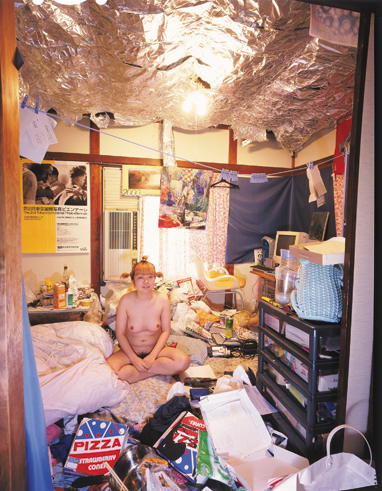Camera Austria International
84 | 2003
- TOSHIHARU ITO
The Topology, The Edges and the Islands of Contemporary Japanese Photography - KAZUE KOBATA
Solidarity and Solitude - MICHIKO KASAHARA
The Changed Conditions of Photography - MASAFUMI FUKAGAWA
From Fujisan to Fujiyama - MINORU SHIMIZU
The Whence and the Wither of Colour Photography. Eggleston, Meyerowitz and the New Generation - SHINO KURAISHI
Unknown Rules – Notes on Takuma Nakahira's Experiments in the early Seventies - TOSHIYA UENO
Rethinking the Cultural and Spatial Turn in Japanese Photography: A Psycho-Photo-Geography of Japan - MAO ISHIKAWA
My Pride as an Okinawan
- KYOICHI TSUZUKI
Universe for Rent - KEIZO KITAJIMA
- KISEI KOBAYASHI
- MIKA NINAGAWA
- SAKIKO NOMURA
- MASAFUMI SANAI
- TOMOKO SAWADA
- RISAKU SUZUKI

Preface
In Camera Austria 1/1980, Tsuno Enari published a series on New York families; as early as 1980 the Forum Stadtpark photo gallery, headed by Manfred Willmann, presented, not least through the agency of Seiichi Furuya, an exhibition of Daido Moriyama (cf. Camera Austria 2/1980); in 1978 and 1984 of Shomei Tomatsu and in 1993 of Miyako Ishiuchi; in 1992, finally, the first individual exhibition of Nobuyoshi Araki outside Japan that was later presented all over Europe; in 1994 the group exhibition of European photographers “Another Continent” was on show at the Tokyo Metropolitan Museum of Photography the exchange between Camera Austria and Japanese institutions and artists has a long tradition. “Keep in Touch. The Social Use of Images”, a project made possible thanks to our co-operation with Graz 2003 – Cultural Capital of Europe and the support of EU Japan Fest, is a reason for us to rekindle this exchange in view of current events.
Read more →Camera Austria International 84 | 2003
Preface
In Camera Austria 1/1980, Tsuno Enari published a series on New York families; as early as 1980 the Forum Stadtpark photo gallery, headed by Manfred Willmann, presented, not least through the agency of Seiichi Furuya, an exhibition of Daido Moriyama (cf. Camera Austria 2/1980); in 1978 and 1984 of Shomei Tomatsu and in 1993 of Miyako Ishiuchi; in 1992, finally, the first individual exhibition of Nobuyoshi Araki outside Japan that was later presented all over Europe; in 1994 the group exhibition of European photographers “Another Continent” was on show at the Tokyo Metropolitan Museum of Photography the exchange between Camera Austria and Japanese institutions and artists has a long tradition. “Keep in Touch. The Social Use of Images”, a project made possible thanks to our co-operation with Graz 2003 – Cultural Capital of Europe and the support of EU Japan Fest, is a reason for us to rekindle this exchange in view of current events. In this issue we document the exhibition “Positions in Japanese Photography” together with the Symposium of the same title and objective: What are the themes of today’s young generation of Japanese artists? What are the cultural premonitions guiding current art production in the face of a highly developed and hence again vulnerable capitalist system? Do Japanese artists take up themes specific to Japanese or Asian culture? If so, how are they influenced by Western developments, considering their strong presence at exhibitions in Europe? And vice versa, given this recent “Japan boom” in Europe, what is their influence on art production in the West?
The exhibition and symposium set out to place Japan’s visual culture in a context of analysis of political and social developments which, in turn, are constantly revising and scrutinising – from the inside, as it were – the idea of what “Japan” could be and mean: Kazue Kobata, for example, with her description of the conflicts and contradictions in the social development of post-war Japan, or Michiko Kasahara with her description of the changed underlying conditions of photography in Japan, particularly the role of women between tradition and postmodern pluralism.
From different angles, Masafumi Fukagawa, Shino Kuraishi, Minoru Shimizu and Toshiya Ueno propose new interpretations of contemporary Japanese photography: against the backdrop of actionist strategies of the nineteen-seventies, with regard to the relationship of image and photographer, by analysing colour as a specific aspect of producing meaning, or by introducing the concept “Site Graphics” based on an analysis of landscape photography of the nineties. Mao Ishikawa, whose work revolves exclusively around the political and cultural situation of Okinawa, describes her role as a photographer between documentation and involvement, between reporting and political activism. The contribution from Toshiharu Ito, finally, summarises the positions of the exhibition under the concept of “edge”, setting out to track down their common background.
The exhibition “Positions in Japanese Photography” also marked the very successful opening of Camera Austria’s new premises at Kunsthaus Graz: more than 28,000 visitors evidence the extraordinary interest in photography and encourage us in our objective to maintain a discussion of contemporary culture beyond the realm of art in our projects – the magazine, exhibitions and symposiums – and to continue our critical observation of cultural developments.
Christine Frisinghelli, Seiichi Furuya, Manfred Willmann
Entries
Exhibitions
Some places to which we can come, and for a while “be free to think about what we are going to do.”
Robert Barry: Works 1963 to 1975
Aarauer Kunsthaus, Aarau, Kunsthalle Nürnberg
HANS-JÜRGEN HAFNER
Abstraction Now
Künstlerhaus, Wien
MARIE RÖBL
Pawel Althamer & Artur Zmijewski: So genannte Wellen und andere Phänomene des Geistes
Kunstverein für die Rheinlande und Westfalen, Düsseldorf
MAGDALENA KRÖNER
Frank Films: Offene Filme
The Film and Video Work of Robert Frank
Diagonale Special “Robert Frank – Retrospektive der Filme und Videos”, Kiz, Graz
BIRGIT FLOS
Valie Export
Centre National de la photographie, Paris, Camden Arts Center, London, Sammlung Essl, Klosterneuburg
JULIA GARIMORTH
Marcello Brodsky: Buena Memoria
Sprengel Museum, Hannover; Haus der Fotografie, Prag; Photofusion, London
FABIAN STECH
Entgrenzte Repräsentation
Ausstellungsprojekte im steirischen herbst 2003, Graz
ULRICH TRAGATSCHNIG
Tastaturen, Bilder, Körper. Zur Ausstellung “games. Computerspiele von KünstlerInnen”
Ehemaliges Reserveteillager des Phönix-Werkes, Dortmund
REINHARD BRAUN
Eigene Orte / Appropriated Spaces
Kunstverein Wolfsburg
SØNKE GAU
Deleuze und die Künste: Wiederholung und Differenz
Symposium: ZKM-Medientheater, Karlsruhe
GISLIND NABAKOWSKI
Ars Electronica 2003: Code – The Language of our time
Festival für Kunst, Technologie und Gesellschaft, Linz
HERWIG HÖLLER
Ein längster Tag. Die US-amerikanische Fernsehserie «24».
HIAS WRBA
Home and Away.
Strangers. The First ICP Triennal of Photography and Video
International Center of Photography, New York
RACHEL BAUM
8th International Istanbul Biennal: Poetic Justice
When Poetry and Justice are Processed as Subjects of a Set of Experiments.
BASAK SENOVA
The Possible Narratives: Art Practices from Lebanon in search of a Memory
An Essay on the Lebanese Artists at the 14th Int. El. Art Fest.-Videobrasil
ANTONIO GONÇALVES FILHO
Robert Mapplethorpe: Eye to Eye
Selected by Cindy Sherman, Sean Kelly Gallery, New York
CARLO MCCORMICK
Books
Stuart Hall / Mark Sealy: Different
Phaidon, London 2001
ANTONIA CARVER
Rethinking Photography I+II. Narration und neue Reduktion in der Fotografie / Narration and Reduction in Photography
Edition Fotohof, Salzburg / Forum Stadtpark, Graz, 2003
MARINA GRŽINIĆ
404 Object Not Found. Was bleibt von der Medienkunst?
medien_kunst_netz dortmund, Dortmund, 2003
CHRISTIANE FRICKE
Imprint
Publisher: Manfred Willmann. Owner: Verein CAMERA AUSTRIA, Labor für Fotografie und Theorie
All: Sparkassenplatz 2, A-8010 Graz
Editors: Christine Frisinghelli, Maren Lübbke, Reinhard Braun, Manisha Jothady. Trainee: Kanako Nasu
Translations: Wilfried Prantner, Richard Watts, scheid & scheid
























